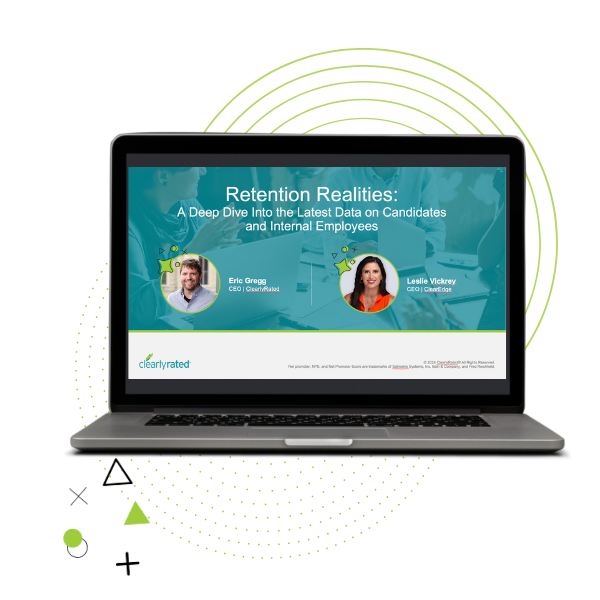Online reviews are powerful marketing tools. Organizations with effective review programs build powerful credibility and are better at earning trust. In fact, our proprietary research shows that 87% of buyers use online ratings and reviews while deciding whether to work with a B2B service supplier. And reviews get even more powerful when customers see them somewhere other than your own website—1.7x more powerful to be exact.
To help companies better understand the power of online reviews, our co-founders Eric Gregg (CEO) and Nathan Goff (CTO) joined forces and held their first-ever co-hosted webinar. They not only discussed how to capture online reviews consistently but also how to use them for business success. Let’s cover the top takeaways.
1. People trust review sites to help them make wise decisions.
Okay, we kinda covered this in the first paragraph, but it’s essential information and we’ll go a bit deeper here. Trust of ratings for review sites are very high—in the 80% range. However, trust varies greatly by generation: The older the generation, the less likely they are to rely on online reviews while making their buying decisions. So, take your target audience into consideration when it comes to seeking reviews and which platforms you utilize. Keep in mind, though, that Millennials and Gen Z are increasingly taking on leadership roles. Don’t overlook their affinity for utilizing online reviews!

2. Make Google a top priority
‘Let’s google it’ has become a common phrase. After all, Google knows everything, right? Try this: Search for your firm on Google and see which review sites show up first. Those are the ones with quality SEO that Google likes. Since Google is the powerhouse of search engines, consider concentrating your efforts on those sites to get your star ratings to appear on search engine results. After all, star ratings grab searchers’ attention.
An important note about Google: Google isn’t exclusive to its Google reviews. Its search results often include star ratings generated by sources other than Google Reviews. So, while Google Reviews is a great tool for obtaining feedback, you don’t have to focus solely on this channel. Plus, for B2B service firms and other niche companies, there are often specialized review platforms used by potential customers and clients. And when several review sites show similar ratings, their collective story builds credibility.
3. Nobody expects your reviews to be perfect.
Not every review will be stellar, but that’s ok–even ideal! You might get some important feedback you can use to improve. Plus, having some variation in your reviews shows authenticity which can improve viewer trust. Consumers are smart—a 4.7 rating can be better than a pure 5.0. Why? It shows people that your reviews aren’t a flurry of fake 5-star praise. So, when you get the inevitable poor review, take a deep breath and remember this: Bad reviews can be overcome. The key is in how you respond, so let’s get to that…
4. Your response matters. Always respond.
As Nathan says, “Not responding is the worst thing you can do.” As you respond to reviews, it shows you care about your customers’ feedback and proves that you’re engaged in providing a great experience. So, capitalize on the goodwill that comes with a positive review. Respond with a heartfelt thanks, making sure to vary any templated responses. When you get helpful feedback, acknowledge it in your response and, if possible, share how you’ll put any suggestions into practice. And when you get a bad review, don’t get combative. Acknowledge the reviewer’s experience and create an opportunity for positive follow-up. You may even get the opportunity to win that reviewer back, along with new clients who see how well you handled the situation. Whatever you do, don’t ignore a negative review and certainly don’t delete it (even if you wield that power).
5. The best way to combat a negative review is to bury it in positive reviews.
Once you’ve responded to a negative review, the next best step is to bury it in positive reviews—and when you ask for reviews, the majority will be positive. Just take a look at this graph that Eric shared during the webinar:

6. Review gating is bad.
Don’t discriminate by asking only those clients who you know will give rave reviews. This is called review gating, and the FTC has been cracking down. When you seek reviews through a formal program, it’s important to ask everyone. The bottom line: Don’t risk drawing regulatory attention. It’s not worth it, especially when you remember that variety in your ratings increases trust anyway.
7. Building reviews is a marathon, not a sprint.
Finally, it’s important to note that collecting online reviews is a marathon, not a sprint. A library of reviews won’t come in overnight. Our research shows that just 2–3% of those asked will leave a review, so don’t stop with one attempt. Power your review efforts with a consistent process, especially because people’s trust in online review sites only shows signs of strengthening over time.
Related resources:
On-Demand Webinar: The Growing Impact of Online Reviews — Get more insights from Eric and Nathan.
Let’s Google It: How to Get Your Star Ratings on Google — Survey Says Podcast Episode during which our client success experts, Bridget Harper and Ryen Salo, discuss specifics about requesting star reviews and getting your ratings to appear on Google.




